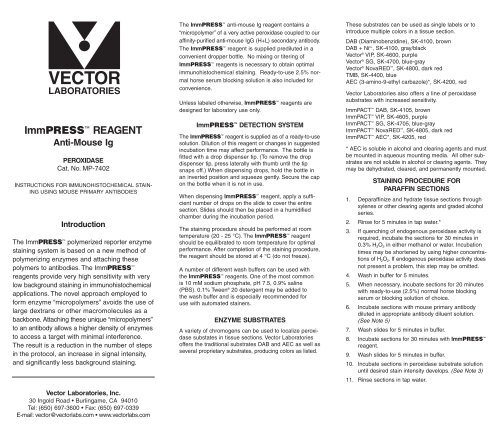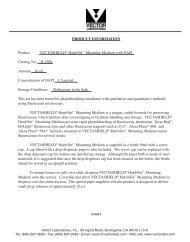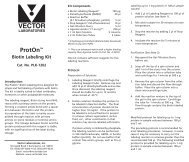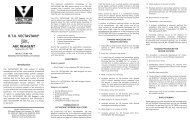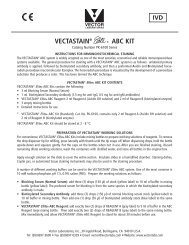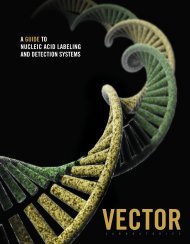Protocol - Vector Laboratories
Protocol - Vector Laboratories
Protocol - Vector Laboratories
You also want an ePaper? Increase the reach of your titles
YUMPU automatically turns print PDFs into web optimized ePapers that Google loves.
VECTOR<br />
LABORATORIES<br />
ImmPRESS REAGENT<br />
Anti-Mouse Ig<br />
PEROXIDASE<br />
Cat. No. MP-7402<br />
INSTRUCTIONS FOR IMMUNOHISTOCHEMICAL STAIN-<br />
ING USING MOUSE PRIMARY ANTIBODIES<br />
Introduction<br />
The ImmPRESS polymerized reporter enzyme<br />
staining system is based on a new method of<br />
polymerizing enzymes and attaching these<br />
polymers to antibodies. The ImmPRESS <br />
reagents provide very high sensitivity with very<br />
low background staining in immunohistochemical<br />
applications. The novel approach employed to<br />
form enzyme “micropolymers” avoids the use of<br />
large dextrans or other macromolecules as a<br />
backbone. Attaching these unique “micropolymers”<br />
to an antibody allows a higher density of enzymes<br />
to access a target with minimal interference.<br />
The result is a reduction in the number of steps<br />
in the protocol, an increase in signal intensity,<br />
and significantly less background staining.<br />
<strong>Vector</strong> <strong>Laboratories</strong>, Inc.<br />
30 Ingold Road • Burlingame, CA 94010<br />
Tel: (650) 697-3600 • Fax: (650) 697-0339<br />
E-mail: vector@vectorlabs.com • www.vectorlabs.com<br />
The ImmPRESS anti-mouse Ig reagent contains a<br />
“micropolymer” of a very active peroxidase coupled to our<br />
affinity-purified anti-mouse IgG (H+L) secondary antibody.<br />
The ImmPRESS reagent is supplied prediluted in a<br />
convenient dropper bottle. No mixing or titering of<br />
ImmPRESS reagents is necessary to obtain optimal<br />
immunohistochemical staining. Ready-to-use 2.5% normal<br />
horse serum blocking solution is also included for<br />
convenience.<br />
Unless labeled otherwise, ImmPRESS reagents are<br />
designed for laboratory use only.<br />
ImmPRESS DETECTION SYSTEM<br />
The ImmPRESS reagent is supplied as of a ready-to-use<br />
solution. Dilution of this reagent or changes in suggested<br />
incubation time may affect performance. The bottle is<br />
fitted with a drop dispenser tip. (To remove the drop<br />
dispenser tip, press laterally with thumb until the tip<br />
snaps off.) When dispensing drops, hold the bottle in<br />
an inverted position and squeeze gently. Secure the cap<br />
on the bottle when it is not in use.<br />
When dispensing ImmPRESS reagent, apply a sufficient<br />
number of drops on the slide to cover the entire<br />
section. Slides should then be placed in a humidified<br />
chamber during the incubation period.<br />
The staining procedure should be performed at room<br />
temperature (20 - 25 °C). The ImmPRESS reagent<br />
should be equilibrated to room temperature for optimal<br />
performance. After completion of the staining procedure,<br />
the reagent should be stored at 4 °C (do not freeze).<br />
A number of different wash buffers can be used with<br />
the ImmPRESS reagents. One of the most common<br />
is 10 mM sodium phosphate, pH 7.5, 0.9% saline<br />
(PBS). 0.1% Tween ® 20 detergent may be added to<br />
the wash buffer and is especially recommended for<br />
use with automated stainers.<br />
ENZYME SUBSTRATES<br />
A variety of chromogens can be used to localize peroxidase<br />
substates in tissue sections. <strong>Vector</strong> <strong>Laboratories</strong><br />
offers the traditional substrates DAB and AEC as well as<br />
several proprietary substrates, producing colors as listed.<br />
These substrates can be used as single labels or to<br />
introduce multiple colors in a tissue section.<br />
DAB (Diaminobenzidine), SK-4100, brown<br />
DAB + Ni 2+ , SK-4100, gray/black<br />
<strong>Vector</strong> ® VIP, SK-4600, purple<br />
<strong>Vector</strong> ® SG, SK-4700, blue-gray<br />
<strong>Vector</strong> ® NovaRED , SK-4800, dark red<br />
TMB, SK-4400, blue<br />
AEC (3-amino-9-ethyl carbazole)*, SK-4200, red<br />
<strong>Vector</strong> <strong>Laboratories</strong> also offers a line of peroxidase<br />
substrates with increased sensitivity.<br />
ImmPACT DAB, SK-4105, brown<br />
ImmPACT VIP, SK-4605, purple<br />
ImmPACT SG, SK-4705, blue-gray<br />
ImmPACT NovaRED , SK-4805, dark red<br />
ImmPACT AEC*, SK-4205, red<br />
* AEC is soluble in alcohol and clearing agents and must<br />
be mounted in aqueous mounting media. All other substrates<br />
are not soluble in alcohol or clearing agents. They<br />
may be dehydrated, cleared, and permanently mounted.<br />
STAINING PROCEDURE FOR<br />
PARAFFIN SECTIONS<br />
1. Deparaffinize and hydrate tissue sections through<br />
xylenes or other clearing agents and graded alcohol<br />
series.<br />
2. Rinse for 5 minutes in tap water.*<br />
3. If quenching of endogenous peroxidase activity is<br />
required, incubate the sections for 30 minutes in<br />
0.3% H 2 O 2 in either methanol or water. Incubation<br />
times may be shortened by using higher concentrations<br />
of H 2 O 2 . If endogenous peroxidase activity does<br />
not present a problem, this step may be omitted.<br />
4. Wash in buffer for 5 minutes.<br />
5. When necessary, incubate sections for 20 minutes<br />
with ready-to-use (2.5%) normal horse blocking<br />
serum or blocking solution of choice.<br />
6. Incubate sections with mouse primary antibody<br />
diluted in appropriate antibody diluent solution.<br />
(See Note 5)<br />
7. Wash slides for 5 minutes in buffer.<br />
8. Incubate sections for 30 minutes with ImmPRESS <br />
reagent.<br />
9. Wash slides for 5 minutes in buffer.<br />
10. Incubate sections in peroxidase substrate solution<br />
until desired stain intensity develops. (See Note 3)<br />
11. Rinse sections in tap water.
12. Counterstain, clear and mount.<br />
* If antigen unmasking is required, perform this procedure<br />
after step 2, using Cat. No. H-3300 (citrate-based) or<br />
H-3301 (high pH).<br />
STAINING PROCEDURE FOR<br />
FROZEN SECTIONS<br />
This procedure is generally appropriate for frozen sections,<br />
cell smears or cytocentrifuge preparations.<br />
1. Sections are air dried.<br />
2. Immediately before staining, fix sections with<br />
acetone or the appropriate fixative for the antigen<br />
under study.<br />
3. Transfer slides into buffer.<br />
4. If quenching of endogenous peroxidase is required,<br />
use gentle H 2 O 2 blocking to reduce the risk of antigen<br />
destruction or tissue loss: 0.3% H 2 O 2 in 0.3%<br />
normal serum in PBS for 5 minutes; or 0.3% H 2 O 2<br />
in methanol for 30 minutes, or use other published<br />
methods (eg. Andrew, S. M., Jasani, B., Histochem<br />
J. 1987, 19, 426-30).<br />
5. Follow steps 4-12 of the procedure recommended<br />
for paraffin sections.<br />
For best results, ImmPRESS reagent should be used<br />
before the expiration date.<br />
NOTES:<br />
1. ImmPRESS reagents can be used in multiple<br />
antigen labeling applications. A brochure is available<br />
with protocols - “Discovery through color”.<br />
Please request a printed copy or download from<br />
our website: www.vectorlabs.com.<br />
2. Solutions containing sodium azide or other<br />
inhibitors of peroxidase activity should not be<br />
used in diluting the peroxidase substrate.<br />
3. Substrate development times may differ depending<br />
upon the level of antigen, the intensity of the stain<br />
that is required, or the substrate used. ImmPACT <br />
DAB and DAB generally should be developed for<br />
2-10 minutes; ImmPACT VIP and <strong>Vector</strong> ® VIP for<br />
2-15 minutes; ImmPACT SG and <strong>Vector</strong> ® SG for<br />
2-10 minutes; ImmPACT NovaRED and <strong>Vector</strong> ®<br />
NovaRED for 2-15 minutes; ImmPACT AEC and<br />
AEC for 10-30 minutes; TMB for 5-20 minutes. Some<br />
counterstains may not be compatible with certain<br />
peroxidase substrates because of solubility of the<br />
reaction products or lack of color contrast. A counterstain<br />
compatibility chart is available upon request.<br />
Refer to the instructions in the respective substrate<br />
kits for further details.<br />
4. The section should be well prepared. Fixation<br />
(generally, in buffered formalin not exceeding 4 percent<br />
formaldehyde) should be sufficient to maintain<br />
the integrity of the section throughout the staining<br />
procedure but not so harsh as to destroy the antigen<br />
under study. During the staining procedure, do not<br />
allow the section to dry out. Use a humidified<br />
chamber for incubations. In some cases, use of an<br />
Antigen Unmasking Solution, Cat. No. H-3300 (citrate-based)<br />
or Cat. No. H-3301 (high pH) and exposure<br />
to high temperatures can overcome loss of<br />
antigens due to fixation.<br />
5. To avoid adsorption of the antibody to the plastic or<br />
glass container in which the final dilution is made,<br />
the primary antibody may be diluted in buffers<br />
containing diluted (2.5%) normal horse serum or<br />
0.1% immunohistochemical grade bovine serum<br />
albumin (Cat. No. SP-5050). Only immunohistochemical<br />
grade BSA should be used, as other<br />
preparations can contain undesired impurities.<br />
6. Use only freshly prepared buffers. Bacterial contamination<br />
which can occur in buffers stored at room<br />
temperature may affect the quality of the staining.<br />
It is recommended that the substrate solution be<br />
prepared with glass distilled water. Deionized water<br />
(even with low conductivities) may contain inhibitors<br />
of peroxidase and can reduce sensitivity.<br />
7. Sections of neuronal tissue or sections which are<br />
thicker than normal may require longer incubation<br />
times for optimal staining.<br />
8. To prevent sections from detaching from the glass,<br />
slides can be treated with VECTABOND Reagent<br />
(Cat. No. SP-1800), a non-protein tissue section<br />
adhesive.<br />
9. After mounting, paraffin sections should be dried in<br />
a hot air oven at 50-56 °C. Some slide warmers<br />
contain “hot spots” that can overheat tissues.<br />
10. Specimens should not be embedded in paraffin<br />
heated higher than 60 °C. Too much heat can<br />
destroy antigens.<br />
11. Hand lotions can cause sections to detach from<br />
slides or may prevent adequate penetration of<br />
reagents. Avoid touching rinse baths with oily<br />
hands.<br />
12. Paraffin tissue blocks should be stored in sealed<br />
containers in a cool location.<br />
13. Complete deparaffinization is important. Clearing<br />
agents and alcohol solutions should be changed<br />
regularly. All steps of the deparaffinization should<br />
be sufficiently long to completely remove the<br />
paraffin from the sections.<br />
14. To reduce the risk of introducing contaminants,<br />
avoid removing the drop dispenser from the stock<br />
solution bottle unless dispensing large volumes.<br />
Avoid pipetting ImmPRESS reagent directly from<br />
the bottle.<br />
Peroxidase Substrates<br />
These kits provide sufficient stock reagents to prepare<br />
about 300 ml of substrate solution:<br />
DAB Substrate 1 Kit SK-4100<br />
<strong>Vector</strong> ® VIP Substrate 1 Kit SK-4600<br />
<strong>Vector</strong> ® SG Substrate 1 Kit SK-4700<br />
<strong>Vector</strong> ® NovaRED Substrate 1 Kit SK-4800<br />
TMB Substrate 1 Kit SK-4400<br />
AEC Substrate 1 Kit SK-4200<br />
More sensitive versions of most of these substrates are<br />
also available as ImmPACT substrates:<br />
ImmPACT DAB 120 ml SK-4105<br />
ImmPACT VIP Substrate 120 ml SK-4605<br />
ImmPACT SG Substrate 120 ml SK-4705<br />
ImmPACT NovaRED Substrate 120 ml SK-4805<br />
ImmPACT AEC Substrate 120 ml SK-4205<br />
Other related reagents also available are:<br />
ImmPRESS Reagent Anti-Rabbit Ig 1 Kit MP-7401<br />
ImmPRESS Reagent Anti-Mouse Ig<br />
(rat adsorbed) Kit MP-7422<br />
ImmPRESS Reagent Anti-Rat Ig Kit MP-7404<br />
ImmPRESS Reagent Anti-Rat Ig<br />
(mouse adsorbed) Kit MP-7444<br />
ImmPRESS Reagent Anti-Goat Ig Kit MP-7405<br />
ImmPRESS Universal Reagent<br />
Anti-Mouse/Rabbit Ig Kit MP-7500<br />
VectaMount Mounting Medium 60 ml H-5000<br />
VectaMount AQ Mounting Medium 60 ml H-5501<br />
Antigen Unmasking Solution (100x)<br />
Citrate-based 250 ml H-3300<br />
High pH 250 ml H-3301<br />
Bovine Serum Albumin (BSA) 500 mg SP-5050<br />
VECTABOND Reagent 7 ml SP-1800<br />
<strong>Vector</strong> ® Hematoxylin 500 ml H-3401<br />
<strong>Vector</strong> ® Hematoxylin QS 100 ml H-3404<br />
<strong>Vector</strong> ® Methyl Green 500 ml H-3402<br />
<strong>Vector</strong> ® Nuclear Fast Red 500 ml H-3403<br />
ImmEdge Hydrophobic Barrier Pen 2-pen set H-4000<br />
ImmPrint Histology Pen 5-pen set H-6100<br />
Mouse IgG Control Antibody 1 mg I-2000<br />
A complete catalog listing is available upon request.<br />
Visit our website: www.vectorlabs.com<br />
VECTOR<br />
©VECTOR LABORATORIES, INC. 2010 IMPRS-M5


